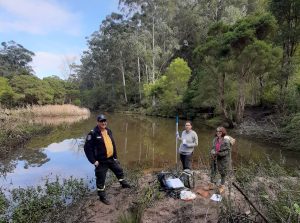Our sampling would not have been possible without the generosity of volunteer citizen scientists (including a number of CHEN members) and students from Western Sydney University (WSU).
A couple of our eDNA testing sites were located on O’Haras Creek and Scaly Bark Creek on the outskirts of Kenthurst. A particular thank you to Andrew Callaghan the Captain of the Kenthurst Rural Fire Service who very kindly agreed to help our eDNA water sampling team get to these sampling sites that were accessed by local fire trails. We visited some beautiful spots and what appeared to be some good platypus habitat.



